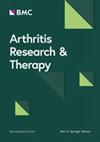Type II diabetes in systemic sclerosis patients: insights from an observational, multicenter study of GIRRCS (Gruppo Italiano di Ricerca in Reumatologia Clinica e Sperimentale)
IF 4.6
2区 医学
Q1 Medicine
引用次数: 0
Abstract
To assess the contribution of Systemic sclerosis (SSc)-specific features on type II diabetes mellitus (T2D) in a large cohort of Italian SSc patients. A total of 613 SSc patients from 11 tertiary Rheumatology Units across Italy were included. All patients underwent full history taking, clinical examination, and relevant laboratory and radiological evaluations. Demographic, socioeconomic, and disease-specific factors were compared between SSc patients with and without T2D. The prevalence of T2D in the study cohort was 7.6%. SSc patients with T2D were significantly older (P < 0.007) and exhibited: higher prevalence of late-stage capillaroscopic pattern (P < 0.001), severe reduction in forced vital capacity (FVC < 50%; P < 0.000), moderate reduction in total lung capacity (TLC 50–69%; P < 0.011), electrocardiographic signs of right ventricular hypertrophy (P < 0.018), higher prevalence of pulmonary arterial hypertension (PAH) confirmed by right heart catheterization (RHC) (P < 0.037) and higher prevalence scleroderma renal crisis (SRC) (P < 0.001); elevated erythrocyte sedimentation rate (ESR) (P < 0.022), and ANA positivity. These patients more frequently assumed angiotensin-converting enzyme inhibitors (ACEi) (P < 0.005) when compared to their non-T2D counterparts, while the use of immunosuppressive therapies was similar between groups. Multivariate analysis identified older age, SRC, and reductions in both TLC and FVC as independent SSc-specific associated factors of T2D. Although the prevalence of T2D in SSc patients is lower than the global estimates reported by the International Federation of Diabetes (IFD), a distinct subgroup of SSc patients with T2D is characterized by unique disease manifestations and complications, including SRC and impaired lung function. These findings underscore the importance of tailored screening and management approaches to address the intersecting metabolic and vascular risks in this population.系统性硬化症患者的II型糖尿病:来自GIRRCS (Gruppo Italiano di Ricerca in Reumatologia Clinica e sperentale)多中心观察性研究的见解
评估系统性硬化症(SSc)特异性特征对意大利SSc患者II型糖尿病(T2D)的影响。来自意大利11个三级风湿病单位的613例SSc患者被纳入研究。所有患者均接受了完整的病史、临床检查以及相关的实验室和放射学评估。比较伴有和不伴有T2D的SSc患者的人口学、社会经济和疾病特异性因素。研究队列中T2D的患病率为7.6%。SSc合并T2D的患者明显年龄较大(P < 0.007),并且表现出:晚期毛细血管镜模式的患病率较高(P < 0.001),用力肺活量严重降低(FVC < 50%;P < 0.000),总肺活量中度降低(TLC 50-69%;P < 0.011),右心室肥厚的心电图征象(P < 0.018),右心导管(RHC)证实肺动脉高压(PAH)的患病率较高(P < 0.037),硬皮病肾危象(SRC)的患病率较高(P < 0.001);红细胞沉降率(ESR)升高(P < 0.022), ANA阳性。与非t2d患者相比,这些患者更频繁地使用血管紧张素转换酶抑制剂(ACEi) (P < 0.005),而两组之间使用免疫抑制疗法相似。多变量分析发现,年龄、SRC、TLC和FVC的减少是独立的ssc特异性T2D相关因素。虽然SSc患者中T2D的患病率低于国际糖尿病联合会(IFD)报道的全球估计,但SSc患者中有一个独特的亚组伴有T2D,其特征是独特的疾病表现和并发症,包括SRC和肺功能受损。这些发现强调了定制筛查和管理方法的重要性,以解决这一人群中交叉的代谢和血管风险。
本文章由计算机程序翻译,如有差异,请以英文原文为准。
求助全文
约1分钟内获得全文
求助全文
来源期刊

Arthritis Research & Therapy
RHEUMATOLOGY-
CiteScore
8.60
自引率
2.00%
发文量
261
审稿时长
14 weeks
期刊介绍:
Established in 1999, Arthritis Research and Therapy is an international, open access, peer-reviewed journal, publishing original articles in the area of musculoskeletal research and therapy as well as, reviews, commentaries and reports. A major focus of the journal is on the immunologic processes leading to inflammation, damage and repair as they relate to autoimmune rheumatic and musculoskeletal conditions, and which inform the translation of this knowledge into advances in clinical care. Original basic, translational and clinical research is considered for publication along with results of early and late phase therapeutic trials, especially as they pertain to the underpinning science that informs clinical observations in interventional studies.
 求助内容:
求助内容: 应助结果提醒方式:
应助结果提醒方式:


